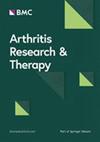Brevilin A, a novel LRRC15 inhibitor, exerts potent anti-rheumatoid arthritis effects by inhibiting the LRRC15/STAT3 signaling pathway
IF 4.6
2区 医学
Q1 Medicine
引用次数: 0
Abstract
Leucine-rich repeat-containing 15 (LRRC15) is a transmembrane protein that is highly expressed in the synovium of patients with rheumatoid arthritis (RA). Brevilin A (BrA), an active compound isolated from Centipeda minima, exerts potent anti-inflammatory effects. However, the anti-RA effect of BrA and its underlying mechanism of action of BrA have not been fully elucidated. Transcriptome analysis was performed to explore biomarkers of RA. An lipopolysaccharide (LPS)-induced RAW264.7 macrophage model, a TNF-α-stimulated RA fibroblast-like synoviocytes (RA-FLSs) model, as well as a collagen-induced arthritis (CIA) rat model were used to explore the anti-RA effects of BrA. Moreover, inhibition or overexpression of LRRC15 was performed to explore the role of LRRC15 signaling in the anti-RA effects of BrA. Transcriptome analysis of patients with RA revealed that LRRC15 expression was significantly upregulated in the synovial tissue of RA patients. BrA significantly downregulated the expression of inflammation-related markers in cell models, and inhibited their proliferation and migration; Moreover, it significantly reduced joint swelling and cartilage damage in CIA rats. Further mechanistic studies suggest that inhibition of LRRC15 inhibits cell proliferation and migration; and overexpression of LRRC15 increases the protein levels of STAT3’s downstream metastasis-related markers. Our findings suggest that BrA, a novel LRRC15 inhibitor, has promising anti-RA activity and potently inhibits LRRC15/STAT3 signaling pathway both in vivo and in vitro. This study not only supports the development of BrA as a novel therapeutic agent for RA treatment, but also paves the way for the development of other LRRC15-targeting therapeutic strategies.Brevilin A是一种新型LRRC15抑制剂,通过抑制LRRC15/STAT3信号通路发挥有效的抗类风湿关节炎作用
Leucine-rich repeat-containing 15 (LRRC15)是一种在类风湿关节炎(RA)患者滑膜中高度表达的跨膜蛋白。从蜈蚣中分离得到的活性化合物Brevilin A (BrA)具有较强的抗炎作用。然而,BrA的抗ra作用及其作用机制尚未完全阐明。转录组分析探讨RA的生物标志物。采用脂多糖(LPS)诱导的RAW264.7巨噬细胞模型、TNF-α刺激的RA成纤维细胞样滑膜细胞(RA- flss)模型和胶原诱导的关节炎(CIA)大鼠模型探讨BrA的抗RA作用。此外,我们通过抑制或过表达LRRC15来探索LRRC15信号在BrA抗ra作用中的作用。RA患者的转录组分析显示,LRRC15在RA患者滑膜组织中的表达显著上调。在细胞模型中,BrA显著下调炎症相关标志物的表达,抑制其增殖和迁移;此外,它还能显著减轻CIA大鼠关节肿胀和软骨损伤。进一步的机制研究表明,抑制LRRC15可抑制细胞增殖和迁移;LRRC15的过表达会增加STAT3下游转移相关标志物的蛋白水平。我们的研究结果表明,BrA是一种新型的LRRC15抑制剂,具有良好的抗ra活性,在体内和体外均能有效抑制LRRC15/STAT3信号通路。本研究不仅支持了BrA作为一种新的RA治疗药物的发展,也为其他lrrc15靶向治疗策略的发展铺平了道路。
本文章由计算机程序翻译,如有差异,请以英文原文为准。
求助全文
约1分钟内获得全文
求助全文
来源期刊

Arthritis Research & Therapy
RHEUMATOLOGY-
CiteScore
8.60
自引率
2.00%
发文量
261
审稿时长
14 weeks
期刊介绍:
Established in 1999, Arthritis Research and Therapy is an international, open access, peer-reviewed journal, publishing original articles in the area of musculoskeletal research and therapy as well as, reviews, commentaries and reports. A major focus of the journal is on the immunologic processes leading to inflammation, damage and repair as they relate to autoimmune rheumatic and musculoskeletal conditions, and which inform the translation of this knowledge into advances in clinical care. Original basic, translational and clinical research is considered for publication along with results of early and late phase therapeutic trials, especially as they pertain to the underpinning science that informs clinical observations in interventional studies.
 求助内容:
求助内容: 应助结果提醒方式:
应助结果提醒方式:


